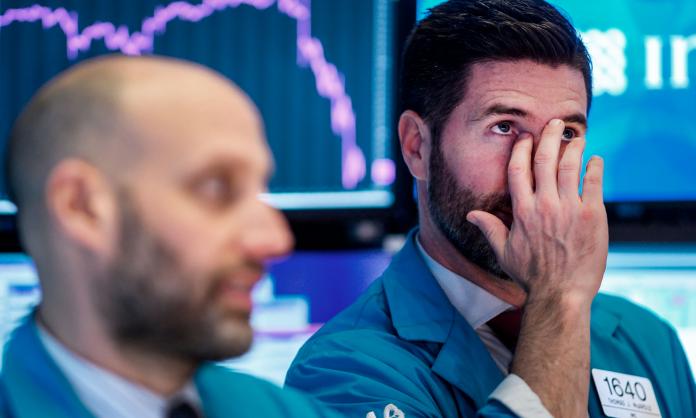We’re experiencing a triple crisis of production: brought about by the Covid-19 virus, a financial bubble bursting and, underlying that, stagnant profits.
Natural disasters have brought about catastrophic falls in production and consumption throughout the existence of the human species. In contrast, purely economic crises are a recent phenomenon resulting from the spread of capitalism. But the two kinds of calamity interact because our world is governed by both scientific laws of physics, chemistry and biology and by the logic of the social system, capitalism, that we inhabit.
The black bubonic plague reduced populations in many parts of Europe and Asia by half and more over a few years in the 1300s.
Bad harvests were the principal cause of the European economic crisis of 1847, which helped trigger revolutions across the continent in the following year.
In Ireland, the crisis was compounded by disease; not of humans, but of potatoes. When blight destroyed the potato crop in the years from 1846, there was mass starvation, mortality and emigration. One million died, two million emigrated – more than a third of the population in 1846.
This was not simply a natural disaster. Potatoes made up about 60 percent of Ireland’s food consumption. The peasants’ poverty and the potato monoculture, which had sustained them and made them vulnerable to the blight, were a consequence of hyper-exploitation by landlords.
During the famine, grain was exported from Ireland. It would not have been profitable to give it to the starving, let alone to import grain to make up for the collapse of potato harvests. Landlords and manufacturers in Ireland and Britain and the government, which served their interests, regarded millions of Irish peasants as dispensable.
----
The political economy of the latest plague has many layers.
The emergence of Covid-19 as a disease of humans can be understood only in the context of patterns of population density and wild food consumption brought about by capitalist development.
The transformation of Covid-19 into a pandemic is a consequence of governments’ inadequate management and funding of public health, and their inadequate responses to it, and has plunged the world into a profound crisis of production.
The deaths, illnesses and suffering directly caused by the disease itself are being compounded by the economic crisis it has started. Plummeting share prices are a spectacular symptom of problems in production due to the health crisis and underlying economic issues.
Employees whose workplaces have been temporarily or permanently shut down for health reasons; those who are looking after kids at home, because schools have been closed; and people in quarantine, sick or dead cannot labour. Tourism has collapsed, international education, a big sector in Australia, is spiralling downwards. The deteriorating situation, which promises lower incomes and depressed markets, deters people from consuming and businesses from investing. The lowering of production of inputs in one sector constrains production by other sectors, within countries and across borders.
Output collapsed in China as factories and other workplaces closed to slow the spread of Covid-19. The Chinese government is encouraging them to reopen, but there is a trade-off between reviving production and reducing contagion. The same pattern is likely to occur in Europe, North America, Australia and beyond.
Around the world, as the pandemic hits, the amount of work that creates the things and services we want and need is plummeting. Economies are contracting sharply. It is clear the world is in the midst of an economic crisis and a recession.
Faced with the health crisis, the attitude of many of the rich and powerful – even old ones, because they can afford expensive private health care if worse comes to worst – was blurted out by Jeremy Warner, an economic journalist and assistant editor at the conservative Telegraph in the UK: “Not to put too fine a point on it, from an entirely disinterested economic perspective, the COVID-19 might even prove mildly beneficial in the long term by disproportionately culling elderly dependents”.
So fewer resources will go to the upkeep of sick and older people no longer generating profits by working. After all, the capitalist economy is about generating profits so they can be reinvested to make more profits. Production under capitalism certainly isn’t about satisfying human needs.
Meanwhile, US Treasury secretary Steven Mnuchin has claimed that the pandemic is “a great investment opportunity”, because shares can be bought up cheaply.
Our rulers also regard the current crisis as an opportunity to push down wages and work conditions, and permanently reduce our civil liberties, because “We’ve all got to pull together”.
This profits-first approach explains why the Australian government is responding to the Covid-19 health crisis as it did to the bushfire crisis: by doing very little to tackle the fundamental problem, then of climate change, now the pandemic.
The Australian government’s tiny health care package is a Gladwrap-thin expression of concern for the welfare of ordinary people while its economic stimulus program consists of give-aways to its business mates.
This pathetic and dangerous response is matched by the Labor opposition. The ALP is “constructively” supporting the government’s measures. Both the conservatives and Labor are driven by their shared priority of putting profits before people. Both want to prevent the crisis from deepening. The measures they endorse won’t do that, for two fundamental reasons.
First, the spread of Covid-19 can be slowed but not stopped. It’s worth slowing it down, so both infection and treatment are spread out over a longer time, and the everywhere inadequate hospital and other health services are not rapidly overwhelmed by many people becoming very sick all at once.
The disruption of economic activity is likely to continue until a vaccine is developed and distributed widely, probably more than a year away. Before a vaccine is available, relaxation of drastic measures, including the quarantining of whole areas, bans on public gatherings and the closure of schools and workplaces, could allow a resurgence of Covid-19 infections.
The second obstacle to rapid recovery is the capitalist organisation of production.
----
The global financial crisis (GFC) or great recession of 2007-08 was the most profound economic downturn since the 1930s. Its immediate cause was the collapse of a bubble of speculation in complicated financial instruments, particularly those based on the assumption that home lending was essentially risk-free for creditors because the real house prices would continue to rise forever.
The current crisis is likely to be worse.
The underlying cause of the GFC and the subsequent period of slow global growth was the mechanism built into capitalist production that generates periodic crises.
Capitalism is characterised by competitive investment in new, more expensive technology, to reduce costs below those of rivals. The amount paid as wages to workers, so that their labour can create new value, falls compared with outlays on machinery, equipment and raw materials. The new value, i.e. profit, created may remain the same or even grow but it is now measured against higher expenditure required to make it. The rate of profit falls.
Of course, there are mechanisms that can offset this tendency for the rate of profit to fall. Otherwise the rate of profit would have fallen since capitalism became the dominant form of productive organisation, and it would have ground to a halt long ago. These mechanisms can be effective for a while but eventually the tendency for the rate of profit to fall reappears and an economic crisis occurs: investment dries up, workers are sacked, productive capacity lies idle, wages are forced down and the living standards of millions fall.
Low profit rates in the real economy foreshadowed both the depression of the 1930s and the GFC. So businesses and individuals with savings, instead of making real investments, engage in financial speculation in shares, public and private bonds, other kinds of loans and more complicated financial instruments (like credit default swaps and collateralised debt obligations in the 2000s).
----
The recovery from the GFC was lacklustre. Some of the most vulnerable corporations in the most developed countries, “too big to fail”, were bailed out by governments. So the devaluation of capital through bankruptcies and desperate sales of productive assets did little to enhance profits by reducing the value of active means of production.
While there was an improvement in the level of real investment, low profits in the productive sector still provided an incentive for what amounts to financial gambling. The Dow Jones index, the main measure of US stock prices, rose 333 per cent from the bottom of the GFC to its peak in December last year, in inflation-adjusted terms.
For at least a year before the pandemic, global growth was slowing; the world economy was already moving towards another recession.
The Covid-19 crash of the stock market has been followed by a dramatic contraction of credit, as occurred during the GFC. The US Federal Reserve on 12 March had to announce that it would offer US$1 trillion for short-term lending to banks and another half trillion the following day. The Reserve Bank, with similar concerns about credit drying up, spent over $5 billion more than anticipated in the equivalent Australian market, propitiously on Friday, 13 March.
Household, corporate and government debt have all grown significantly since the GFC, making the global economy more vulnerable to worsening credit conditions, especially interest rates. And rates demanded by private banks can escape the control of central banks in a severe credit crunch.
So far, the contraction of employment, like the closure of 100 Flight Centre travel agencies and widespread layoffs of casuals, has mainly been due to the direct effects of the pandemic. That will change as the combined effects of the health crisis and the weak economy lead to further contractions in credit and demand, sackings, bankruptcies and falling output.
Neither fiscal nor monetary policies will have much effect. Short-term increases in government spending may temporarily help sectors providing relatively cheap consumer goods, while handouts and tax cuts for businesses can help their bottom lines for a while. But they won’t invest in the short term unless they think these concessions are permanent and will sustain profits in the long term. And investment is crucial.
Investment is the most volatile component of national expenditure. It can virtually cease. Consumer spending can’t, because working people have to spend the bulk of their income on food, clothing and shelter.
If higher government transfers or tax cuts for business become permanent, they may help recovery by raising profit rates – at our expense. To pay for them, either taxes on workers will increase to fund public expenditure and public debt servicing and/or spending on health, education and welfare for workers will be cut.
Monetary policy, particularly low central bank interest rates, failed to generate a robust recovery after the GFC. The European Central Bank’s interest rates have been negative since 2014 (in other words, depositors are charged a fee to hold money in its accounts). Most German banks have now passed this on to corporate customers, some to ordinary account holders. Further rate cuts are no path out of the current recession.
During and after the GFC, massive printing of money by the US, European and Japanese central banks, in the form of “quantitative easing”, failed to propel those economies into consistently robust growth.
Eventually the global economy will recover, as the effects of Covid-19 decline and significant new investment starts again. But the mechanisms that gave rise to it will still be there and will give rise to further disasters.
To escape from the cycle of capitalist crises, whether they are generated by the system’s laws of accumulation or its disastrous interaction with natural processes, we have to escape from global capitalism. That escape is not to planet B but to a new mode of production.









